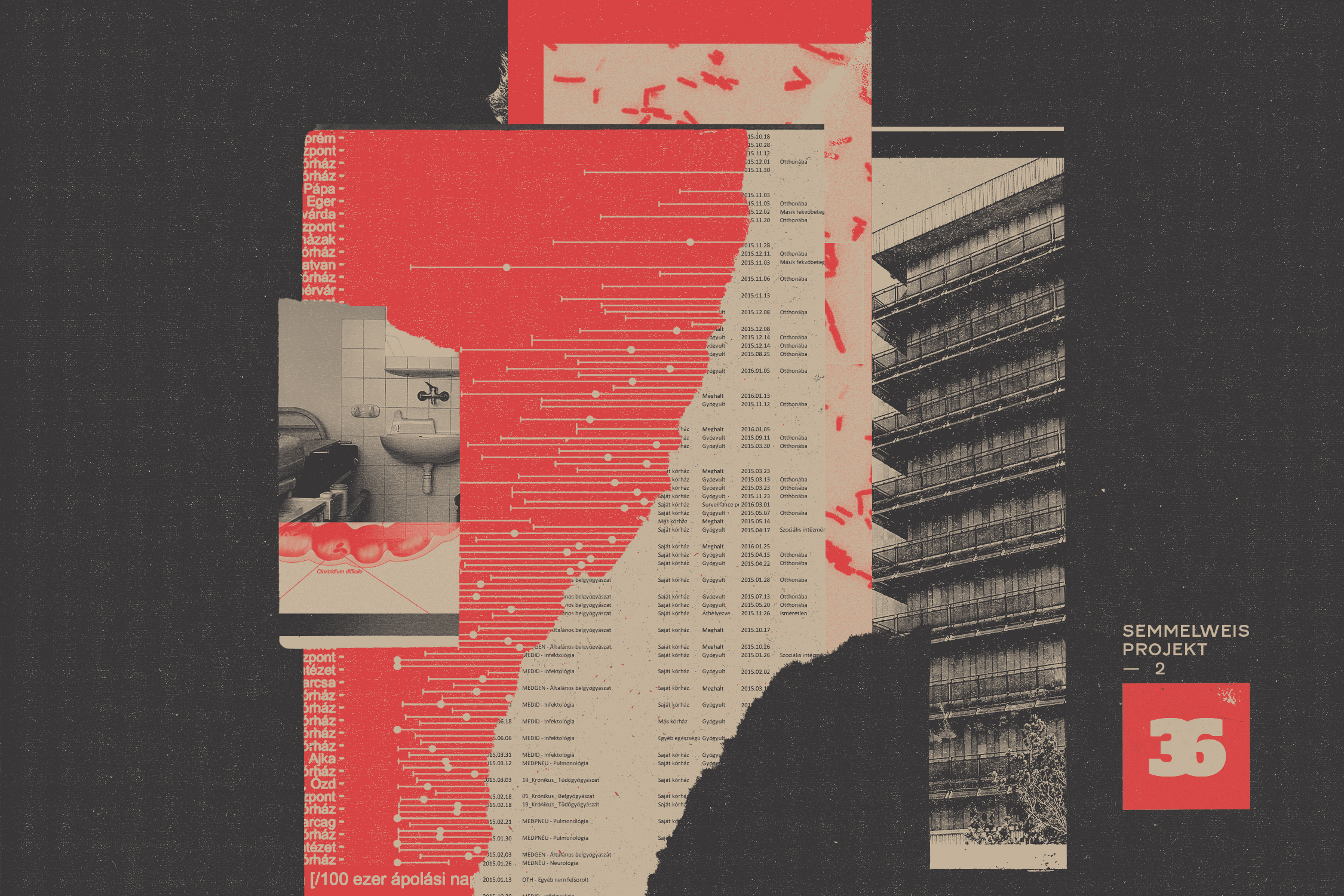Until now, it was a secret how Hungarian hospitals were dealing with infections. Direkt36 has created and now publishes their ranking.

If a patient in Great Britain or in the United States wants to know how well or badly a hospital or the trust operating the hospital is dealing with infections, they can easily look it up online in a public database.
In Hungary, authorities are keeping this secret despite the fact that, as we presented in the first part of our Semmelweis Project series, national statistics clearly show the situation to be serious and worsening each year. Direkt36 is now publishing the first data analysis that provides an overview of the infection situation in different hospitals.
The main findings of the analysis are the following:
- large hospitals treating serious cases do not always have proportionally high rates of infections, and in fact there are some smaller institutions that perform poorly for all types of infection;
- based on the reported infections, there are a lot of problems in Budapest hospitals, as well as in several city hospitals elsewhere in the country. The most affected departments are intensive, surgical and internal medicine wards, but we have also found a case of an outbreak in a psychiatric ward;
- hospitals attribute only a very small percentage of patient deaths to hospital-acquired infections, yet in 30-40% of cases the patient dies;
- our analysis identified major problems in the Jahn Ferenc, Károlyi Sándor, Szent János and Bajcsy-Zsilinszky hospitals of Budapest, among others. In the case of pathogens resistant to antibiotics, the hospitals of Cegléd, Eger and Pápa performed very poorly.
The comparison is based on data from previous years, which the Hungarian Civil Liberties Union has obtained from the state through a lawsuit and made available to us. The data is from 2015-16, however, there are several indications that the situation has not changed significantly.
Firstly, hospital-acquired infections have continued to rise year after year, and a record amount of infections were reached during the coronavirus pandemic: by 2021, the total amount of hospital-acquired infections had increased by around two and a half times compared to 2015. The overall trends revealed by the 2015-16 data have not changed either.
No data is available for individual hospitals since then, but there is region-specific information in the public statistics of the National Centre for Public Health and Pharmacy (NCPHP). These show that the same regions – mainly Central Hungary and the northern part of the Alföld region – continue to perform poorly every year. (The detailed hospital infection figures for the period 2017-2021 have again led to a lawsuit against the NCPHP. Direkt36 won the case in the second court of appeal, but the NCPHP has so far only provided some parts of the data. We are still waiting for the database that the court has ordered, which gives a detailed picture of the real situation.)
How it was made
The original raw database received from the HCLU consisted of four pdf files containing all the data (excluding personal data) on all hospital-acquired infections reported to the NCPHP between 2014 and 2016: when, where, what type of infection occurred, what underlying diseases the infected person had, how they were treated and what their fate was – whether they died or recovered, and if they died, whether their death was related to the hospital-acquired infection. The files contained a total of 6189 pages, tens of thousands of rows of data on the infections, only they were a complete mess. However, with the help of a team of data analysts and researchers from the international journalism organization OCCRP (Organized Crime and Corruption Reporting Project), we managed to turn them into a manageable database.
There were a number of obstacles to correctly analysing the data, so we asked Tamás Ferenci, one of the country’s most renowned biostatisticians for help. He has used a total of 21 statistical computing models, and filtered out differences between patients and between hospitals, to produce an analysis that allows an objective assessment and comparison of the performance of individual hospitals.
You can also read a longer account of how we worked at the end of the article. You can find Ferenci’s own in-depth methodological description here.
Here are the results
Below you can see the rankings of Hungarian hospitals by different hospital-acquired infections. At the top of the charts are the hospitals with the highest incidence rates, and at the bottom are the hospitals with the lowest. The number in the “Incidence” column shows the number of infections per 100,000 patient days, according to our calculations. You can also filter by location in the search box. (We have created three different charts as the NCPHP also collects data on different infections separately, and the numbers cannot be simply added together due to possible overlaps.)
The first chart shows infections caused by multidrug-resistant pathogens by hospital. These are bacteria that are resistant to several types of strong antibiotics, which is why they are so dangerous: they are difficult to kill and can cause serious complications for already sick patients.
The second chart shows the incidence of Clostridium difficile infections. This is a common hospital-acquired infection causing severe diarrhea and, in weakened hospital inpatients, can lead to life-threatening bowel inflammation if not treated properly. Once again, the most problematic hospitals in terms of reported infections are at the top of the list.
The third graph shows the incidence of bloodstream infections. These are cases in which pathogens enter the bloodstream and cause a very serious condition - sepsis or septicaemia - which is fatal in a significant proportion of cases.
If you are also interested in the ranking of each hospital department, you can also browse through that: here you can download the multidrug-resistant pathogen infections per 10 000 patients and 100 000 patient days, here the clostridium infections per 10 000 patients and 100 000 patient days and here the bloodstream infections per 10 000 patients and 100 000 patient days
And from here you can download in xlsx format the full, original database on which our analysis is based: all the data for all reported infections, by hospital and hospital department.
Large hospital, small hospital
The charts clearly show the large differences in the incidence of infections between hospitals, even after adjusting for biases. There is also huge deviation in the number of cases: there is a Hungarian hospital that, for example, has not reported a single clostridium infection (and thus does not appear in the ranking), and another that has reported well over 400 in a single year. The same is true for multidrug-resistant pathogens and bloodstream infections.
For infections caused by multidrug-resistant pathogens, the four hospitals with the most problems are smaller institutions. In first place is Toldy Ferenc Hospital in Cegléd, where these pathogens are the most common in the whole country, according to our calculations. Markhot Ferenc Hospital in Eger and Gróf Esterházy Károly Hospital in Pápa do not compare well either. Károlyi Sándor Hospital in Budapest is among the worst in all three types of infection - in the top five.
We did not rank how many people died from infections in each hospital. Although a large percentage of patients who get an infection never return home, hospitals only see a link between death and infection in a small portion of cases. The assessment of what led to the death of a patient is highly subjective, with often no time to investigate the causes thoroughly, and also depends on self-reporting by hospitals.
The situation is similar when an infection in a particular department reaches epidemic proportions. If an outbreak occurs in a hospital, the NCPHP must investigate it in all cases. However, deciding when cases start to accumulate suspiciously, when they turn into an epidemic and whether they are linked to each other at all is complicated and proving it depends on many factors.
Nevertheless, a lot can be gathered from our database about reported outbreaks and deaths where hospitals themselves have seen a link between the infection and the death of the patient - even if the relevant boxes are often filled out incompletely.
For example, only 17 institutions admitted to the NCPHP that a hospital-acquired bloodstream infection was the clear cause of a patient's death, for a total of 129 patients, even though almost 40 percent of cases of bloodstream infection (2632 cases in two years) ended with death. In other words, according to the hospitals, bloodstream infections were the definite cause of death in less than 2 percent of cases.
In two years, 8493 cases of infections caused by multidrug-resistant pathogens were reported according to our database, in 32% of which patients died, but in only 4% of which hospitals saw a link between death and infection. When outbreaks of these pathogens did occur, it was mostly in intensive care units.
Clostridium difficile is a spore-forming bacteria that causes diarrheal infections in hospitals quite frequently: more than 10,000 cases have been recorded in hospitals in two years. There is a lot of data about them in the charts, outlining several outbreaks quite clearly.
The infectology department of Magyar Imre Hospital in Ajka reported 64 cases of clostridium outbreaks in two years, with a few cases almost every month. Similarly, the pulmonology department at Szabolcs-Szatmár-Bereg University Teaching Hospital in Nyíregyháza has repeatedly been affected, as have various departments at Szent János Hospital in Budapest. Several departments from cardiology to internal medicine and traumatology were affected, even the departments of ophthalmology and psychiatry.
Direkt36 interviewed Dr. Ágnes Galgóczi, Head of the Hospital Hygiene and Regulatory Division, who we asked, among other things, whether the experts of the NCPHP know which hospitals in Hungary have the highest incidence of hospital-acquired infections, however, we did not receive a clear answer.
"Our role is to provide professional recommendations for the prevention of infections related to specific pathogens. It is the responsibility of hospital operators to provide the necessary human and financial resources", Galgóczi said.
She also added that, under the legislation, government agencies have to meet with the infection control committees of health institutions that are trying to fight infections in their hospitals. Galgóczi, however, could not say whether any professional meetings between the problematic hospitals identified in our analysis and the county committees have taken place in recent years.
We contacted the mentioned hospitals, but none of them answered our questions.
A corpse in the bathroom
We did not have the opportunity to explore the reasons behind the performance of all hospitals individually, however, we wanted to take a closer look at some of the seemingly more problematic hospitals to see what is behind the high number of reported infections. Therefore, we selected four of the hospitals that are among the worst performers in our rankings for all three types of infection. These are Toldy Ferenc Hospital in Cegléd and Jahn Ferenc Hospital, Károlyi Sándor Hospital and Bajcsy-Zsilinszky Hospital in Budapest.
Toldy Ferenc Hospital in Cegléd is the place where - at least according to the 2015-16 data - superbugs resistant to antibiotics are infecting patients at the highest rate in the whole country. At the hospital in Cegléd, they know there's a problem. In a document uploaded to their website, which reads lika a cry for help - and which sets out the hospital's strategy for 2018-2023 - they openly admit that "the number of infections caused by special multidrug-resistant pathogens is increasing year by year, while no new antibiotic is expected to be developed to solve this problem. In the treatment of (...) infectious patients, the difficulties of isolation and the insufficient number of isolation wards are a cause for concern. The prevalence of (...) infections is also currently making medical work difficult."

The Toldy Ferenc Hospital in Cegléd - Source: hospital website
They also describe the dramatic conditions under which the staff of the institution have to provide treatment. They say that the Pesti Road facility is in conditions "reminiscent of the 1950s", with a steadily increasing volume of patients in the four-bed surgery unit, which has long been over capacity.
"The wards are overcrowded, with 6-8 beds and we have no wards with separate water blocks (...). In summer months, the heat in the wards is unbearable. The kitchen, the laundry and the energy centre also need renovation",
says the report, which also points to a critical shortage of doctors and specialist staff and the inability to replace doctors of retirement age with residents. Resignations are frequent.

The Jahn Ferenc Hospital - Source: hospital website
None of this helps to reduce infections. Our database shows that the surgical, intensive care, urology, cardiology and neurology departments have serious difficulties in preventing infections. For multidrug-resistant infections alone, the hospital has reported 130 cases in two years. There have been 145 cases of clostridium infections acquired in the hospital and 74 patients have received blood poisoning as a result of infections in the two years.
According to our calculations, Jahn Ferenc Dél-pesti Hospital had the highest prevalence of clostridium difficile infections in the whole country, with the most severe situation in the internal medicine department in 2015-16. The institution ranked fifth worst for multidrug-resistant pathogens. An exceptionally high amount of infections occurred in the hospital's psychiatric ward, where out of the reported 7 cases in two years, 3 patients died from infections of MRSA and Acinetobacter baumannii pathogens.
Jahn Ferenc Hospital is struggling with the well-known problems of Budapest's major hospitals, from outdated infrastructure to severe staff shortages and overcrowding to a lack of funding. In 2022, more than 1,500 people worked at the hospital, but 332 positions were unfilled.
Overcrowding and inadequate cleaning may have led to the 2016 national scandal following the discovery of a dead body in a visitors' restroom at the hospital. As it turned out, the corpse had been lying there for days. The hospital launched an investigation, apologised and concluded that no one was at fault, nevertheless a number of changes were announced regarding the use of toilets, the operation of the reception service and cleaning. The cleaning service, for example, was " partially taken back into institutional responsibility to ensure higher standards".
This, however, did not last long, as in 2018 they contracted the external company responsible for cleaning the hospital at the time of the incident. The company won against several applicants because it significantly underbid the hospital's estimated price: it undertook the work for 60 percent less. Price was a deciding factor of 98 percent at the time of the evaluation, while quality accounted for 2 percent.
They can't stop infections in Újpest either
Károlyi Sándor Hospital in Újpest has a much lower volume of patients than Jahn Ferenc, yet according to our calculations it still has one of the highest infection rates in the country: uniquely, it is among the worst five institutions in all three infection types. Within two years, the hospital has reported over a hundred cases of both clostridial and multidrug-resistant bacterial infections.
There is little public information about the work being done within the walls of Károlyi Hospital, although the documents uploaded to the hospital's website reveal a lot. Staff turnover is very high, with more than half of the hospital's staff leaving in 2011, hundreds of people leaving over the last decade, and by 2021 the number of staff have halved compared to ten years earlier.
Like Toldy Ferenc Hospital, Károlyi Hospital also has published a pessimistic report for the year 2021, which is the last available written report on their official website.
In a document signed by the hospital's Chief Financial Officer and Director, they stress that the institution has been struggling with underfunding for a decade, its IT system is outdated and staff headcount is constantly decreasing. They added that the introduction of the 2020 law on employment in the health service has led to a further decline in staff numbers, as more staff have not signed new contracts.
"Further reductions in staffing levels, which are barely adequate for current patient care activities, would put patient care at risk,"
they write, adding that underfunding has resulted in only 315 posts being filled instead of the 364 needed to run the hospital.
The toughest surgical and internal medicine department in the country
Bajcsy-Zsilinszky Hospital is a large institution: it serves patients from Kőbánya, Rákosmente, Monor, Gyömrő and their surrounding areas, treating 40,000 inpatients a year. Our calculations of infection incidence ranked Bajcsy as the sixth worst performing hospital in the country for the most common types of infections: for both clostridium difficile andinfections caudes by multidrug-resistant pathogens.

The Bajcsy-Zsilinszky Hospital - Source: hospital website
Outbreaks have also occurred, for example in the department of internal medicine, where an outbreak of clostridium affected 14 people in the summer of 2015 alone (May to September). This is hardly surprising, as our calculations based on 2015-16 data show that the hospital's internal medicine department is the second worst in the country when it comes to diarrheal infections. Other areas that ranked poorly include the surgical (4th) and the infant and paediatrics department (1st).
In two years, 74 people were infected with MRSA, 56 with Acinetobacter baumannii and also 56 with MECO. These acronyms denote common multidrug-resistant pathogens whose infections can lead to very dangerous complications among hospitalised patients. This type of infection, resistant to antibiotics, is so common in the surgical and internal medicine departments of Bajcsy that they received the worst ranking in the country according to our calculations.
Beáta Dunavölgyi, a former nurse at the hospital, recalls there were many shortcomings in the institution.
She worked full-time in the oncology department for most of the 2000s and 2010s, and was deputising in the surgical department. „The surgical department was a disaster. It was hot, the air-conditioning didn’t work and they put a fan in the septic area. You can imagine what was spreading in the air”, she recalled. The cleaning, she said, was done by the hospital's employed cleaners, who were all very elderly.
"Poor Mária was pushing the cart at the age of 84 and helping to serve food, it was a disaster. There were other cleaners like that, well, they clowned around like that,"
she said, referring to the fact that hospital cleaning was entrusted to people who were too old for this physically hard job. "There was cleaning every day, but it was not that professional," she noted.
The nurse explained that the hygiene team came every 3 months and told them how to wash their hands and disinfect, but no one inspected whether they were abiding by the instructions. One of the reasons for this is that the hospital does not have the right equipment, and therefore cannot ensure that these rules are followed.
"There were not enough rubber gloves, disinfectant, nappies, sheets, the list goes on. The rules can't be followed like this," said the nurse, adding that if a hospital-acquired infection had occurred, they did not investigate why it happened, they only isolated the patient using a privacy screen.
"Not by placing the patient in another room, but with a screen. We are supposed to be suited up at such an occasion, but in practice we put on a kind of apron and a mask,"
she said. She also noted that no feedback or statistics were shared on how many cases of infection or even malpractice had occurred, there for they did not talk much about these things.
None of the detailed four hospitals answered Direkt36's questions.
It has only got worse since then
In the years since the data on which the comparison is based was collected, there has been a clear deterioration regarding hospital-acquired infections, as can be seen from the national statistics of the NCPHP. In fact, during the 2010s, the number of hospital-acquired infections reported by hospitals in Hungary has essentially increased year after year, with some fluctuations, for all three types of infections for which data collection is mandatory.
Moreover, there are even more infections actually occurring, only a proportion of them are not reported to the NCPHP or are undetected by hospitals.
This is proven by a 2017 National Public Health and Medical Officer Service (NPHMOS) record in our possession, in which a fatal hospital-acquired infection that occured in Szikszó in 2015 was investigated.
The document revealed the victim to be a woman from Homrogd who was hospitalized due to a bilateral leg ulcer and developed severe diarrhea while recovering. Despite receiving medication and infusions her health was deteriorating, and she died a week later. The investigation indentified several mistakes, one of which was not collecting the woman's stool sample in time, resulting in her late diagnosis of clostridium difficile. As a result, by the time they were able to start treating the infection, the elderly patient was in an "unnourishable" condition and died soon after.
However, the tragedy of the woman from Homrogd was not included in national statistics as the hospital did not report the case.
Meanwhile, almost 6,000 multidrug-resistant pathogen infections were reported in 2019, the year before Covid pandemic, while the number of clostridium difficile infections also reached nearly 6,000, and bloodstream infections exceeded 4,500 in 2019. It is also apparent that the incidence has also been increasing almost steadily in relation to patient volume. This trend has not changed for any of these types of infection.
Then came Covid, and everything became even worse. Interventions for less serious cases were postponed, intensive care and covid wards became filled with infected people gasping for air, suffering from serious underlying conditions, while nurses untrained in caring for the seriously ill had to be put to work next to ventilators. While the number of cases of hospital-acquired infections did not rise in Austria and Germany during Covid, in the shadow of Coronavirus the already well-known hospital-acquired infections were still spreading and taking their victims among the weakened patients in Hungary, despite all the protective suits, rubber gloves and hand disinfection.
The NCPHP's national statistics clearly show the serious crisis that has emerged in the health sector. The incidence of all three types of infections has increased by around two and a half times compared to 2015. At least according to the number of infections reported to the NCPHP by hospitals - and this does not include the number of covid infections contracted in hospitals, which was quite common. (We have previously uncovered the story of several hospital outbreaks of coronavirus, which can be read here and here.)
According to Dr. Ágnes Galgóczi, the NCPHP's professional responsible for the issue, the number of hospital-acquired infections increased so dramatically during the coronavirus epidemic because hospitals were not prepared to isolate patients properly and the "patient material", i.e. the condition of the people admitted to hospital changed. "Covid infection, even with healthy people, could result in long ICU stays, a major risk factor for nosocomial infections [hospital-acquired infections]", Galgóczi said.
In contrast, in Austria the incidence of clostridium difficile has decreased during the years of Covid, which the Austrian Ministry of Health's press spokesperson attributed to the success of the stricter measures.
We have not received an answer from NCPHP as to why such a large gap developed between Hungary and Austria during the epidemic.
In the first part of our series, we showed how the political establishment is trying to sweep the problem under the carpet, and how it is more serious than official statistics suggest.
In the next parts of the Semmelweis Project, we will look into how the problem of infections is being faced at the level of hospitals, from the perspective of staff and patients, and how other countries are managing the problem - more successfully than we are.
To follow further articles in this series, sign up to receive alerts on our investigations.
Cover photo by Péter Somogyi (szarvas) / Telex
How we processed the infection data
The original raw database received from the HCLU consisted of four pdf files containing all the data (excluding personal data) on all hospital-acquired infections reported to the NCPHP between 2014 and 2016: when, where, what type of infection occurred, what underlying diseases the infected person had, how they were treated and what their fate was - whether they died or recovered, and if they died, whether their death was related to the hospital-acquired infection.
The pdf files contained a total of 6189 pages, tens of thousands of rows of data on the infections, but in a completely unintelligible way: some tables were cut up, and 2014 data were recorded in a completely different system from those for 2015-16. The first task was therefore to turn the chaos into a manageable database.
For this purpose, Direkt36 journalist Zsuzsanna Wirth asked for the help of international journalist organisation OCCRP's (Organized Crime and Corruption Reporting Project) data analysis and research team. Together with the data scientists - within the framework of the OCCRP's fellowship programme in Sarajevo - after several days work, we managed to interpret the tables, and then organize them into an analysable csv format and clean the database. In the end, we were only able to make the data for 2015-16 usable for analysis, but beyond that the data loss was not significant.
Finally, we had one big table on each type of infection: multidrug-resistant pathogens, bloodstream and clostridium difficile infections. The three databases contain a total of 25,982 rows, which provide an unprecedented amount and range of information.
All that remained was to figure out how to analyse the data in a way that would not lead to false results. We were keen to avoid any misinterpretation of the hospitals' performances, especially as the NCPHP itself consistently argues against providing the public with detailed information on hospital-acquired infections, precisely due ot he risk of misinterpretation.
To achieve this, Tamás Ferenci, one of the most renowned biostatisticians in the country, helped Direkt36. Ferenci helped because he is convinced that transparency and open communication, treating patients as partners, will help develop Hungarian public health and increase trust in the system. „The detailed analysis of data on hospital-acquired infections helps to identify opportunities for improvement and motivates better performance. It is true that such rankings can cause trouble if the public does not interpret the figures correctly, but the answer is not to not produce them, but to produce them well: for example, to communicate results with appropriate explanations, put in context and with the necessary statistical corrections”, he said. He added that it would be better for everyone - not just patients, but also hospitals and healthcare decision-makers - if they could base their decisions on data, and hospitals themselves could benefit from knowing how well they are doing and where they need to improve infection prevention.
Tamás Ferenci has spent several weeks preparing a statistical analysis of the database that allows an objective assessment of the performance of individual hospitals by removing the factors causing uncertainty, providing a detailed picture of the situation in Hungary. A statistical analysis of this depth - at least one that is publicly available - has never been carried out on hospital-acquired infections in Hungary before.
However, this required eliminating a number of problems that would have distorted the results.
Without a background in statistics, it is clear that it makes no sense to rank hospitals based on the number of reported infections, since it is only logical that many more infections occur in busy hospitals than in small ones. It is much better to use the well-established indicator called incidence density also used by the NCPHP, which shows how many infections there are per 100,000 "patient days" in a hospital. This is relatively easy to calculate on a per-hospital basis by linking hospital inpatient flows to the NCPHP data (available on the website of the National Health Insurance Fund, NHIF).
But this is far from good enough, as some hospitals would fare very poorly in these rankings. For example, where they treat patients who are more susceptible to infections and have more serious conditions - as is typically the case in the intensive care unit of a large university hospital - there are logically more infections than in the ophthalmology department of a small hospital, where they treat patients with much less critical conditions. Therefore, it really matters what kind of departments a hospital has. To eliminate this problem, Ferenci has therefore calculated the incidence of infections by type of hospital department, using NHIF data once again. This made it possible to compare individual urology, internal medicine, intensive care units, etc. rather than entire hospitals.
Still, he was not satisfied, as differences of patients were still not accounted for, and it matters a lot how serious the cases are in different hospitals. There can also be major differences between the same departments of different hospitals. Here again, it was necessary to look for another database, in addition to the NCPHP's figures, which provides information on the condition of patients admitted to hospitals. To accomplish this, he used the so-called case-mix index, also published by the NHIF, which, very simply put, refers to the number of complicated cases that certain hospitals have treated in the years examined. This allowed him to incorporate the 'patient mix' into the analysis and to ultimately filter out any resulting biases as much as possible.
As Ferenci was now able to exclude the different department and patient compositions from his calculations, he finally produced the final rankings using so-called regression statistical modelling (more information on this can be found on Ferenci's YouTube channel here). The essence of this is that the model ranks hospitals by using our database to estimate how many infections they would have if they were "the same": that is, if all the hospitals examined had the same complexity of cases, the same number of wards and the same number of patients. This modelling can be carried out in a number of ways, so Ferenci tried a total of 21 different statistical computing models to see if there was any significant difference between their results, but reassuringly, there was none.
Based on that he concluded that there is a 'hospital effect', meaning that there are meaningful differences in infection rates between hospitals even when differences in hospital wards and patient characteristics are removed. In other words, hospitals differ in terms of their success in preventing infections. This may be related to, for instance, the professionalism of their infection control team, the number of nurses per patient, the quality of cleaning or the practice of thorough hand disinfection. This is what the analysis reveals, ultimately giving a picture of how hospitals are performing.
That leaves just one important factor to consider when browsing the final rankings of hospitals below. The entire original database only shows infections found by hospitals and reported to the NCPHP. Officially, this problem does not exist, as the mandatory reporting of infections is required by law, yet in practice there are discrepancies. As we already wrote in the first part of our series of articles, some institutions may not detect infections or confirm them with laboratory tests, while others may detect them but fail to report them. Meanwhile, other hospitals may be more conscientious: they collect samples more often from patients with suspicious symptoms and thus confirm more infections - making their numbers look worse by doing a more thorough job. It is not clear how much of a role this plays in the variation between hospitals. Even the NCPHP itself cannot measure this effectively, other than by spot checks, the results of which are not made public.



